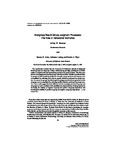Intergroup bias in group judgment processes: The role of behavioral memories
| dc.contributor.author | Sherman, JW | en |
| dc.contributor.author | Klein, SB | en |
| dc.contributor.author | Laskey, A | en |
| dc.contributor.author | Wyer, NA | en |
| dc.date.accessioned | 2014-04-03T11:59:59Z | |
| dc.date.accessioned | 2014-04-03T12:00:07Z | |
| dc.date.available | 2014-04-03T11:59:59Z | |
| dc.date.available | 2014-04-03T12:00:07Z | |
| dc.date.issued | 1998-01 | en |
| dc.identifier.issn | 0022-1031 | en |
| dc.identifier.uri | http://hdl.handle.net/10026.1/2961 | |
| dc.description.abstract |
Two experiments examined the role of memory for behavioral episodes in judgments about in-groups and out-groups. Using a minimal group paradigm, participants read either positive or negative trait-relevant behaviors performed by group members. They then were asked to make judgments about the group's trait characteristics. Results demonstrated that for groups described positively, judgments about the out-group but not the in-group were accomplished by retrieving from memory specific behaviors performed by group members. In contrast, for groups described negatively, judgments about the in-group but not the out-group were accomplished by retrieving specific behaviors performed by group members. These results suggest that basic differences in the way judgments about in-groups and out-groups are made contribute to the establishment and perpetuation of intergroup bias by decreasing the stability of negative in-group and positive out-group impressions and increasing the stability of positive in-group and negative out-group impressions. (C) 1998 Academic Press. | en |
| dc.format.extent | 51 - 65 | en |
| dc.language | EN | en |
| dc.language.iso | EN | en |
| dc.publisher | ACADEMIC PRESS INC | en |
| dc.relation.replaces | http://hdl.handle.net/10026.1/2960 | |
| dc.relation.replaces | 10026.1/2960 | |
| dc.subject | OUT-GROUP HOMOGENEITY | en |
| dc.subject | IN-GROUP | en |
| dc.subject | SOCIAL CATEGORIZATION | en |
| dc.subject | GROUP VARIABILITY | en |
| dc.subject | TRAIT JUDGMENTS | en |
| dc.subject | ATTRIBUTION | en |
| dc.subject | SELF | en |
| dc.subject | REPRESENTATION | en |
| dc.subject | STEREOTYPES | en |
| dc.subject | IMPRESSIONS | en |
| dc.title | Intergroup bias in group judgment processes: The role of behavioral memories | en |
| dc.type | Journal Article | |
| plymouth.issue | 1 | en |
| plymouth.volume | 34 | en |
| plymouth.journal | J EXP SOC PSYCHOL | en |
| dc.identifier.doi | 10.1006/jesp.1997.1342 | en |
| plymouth.organisational-group | /Plymouth | |
| plymouth.organisational-group | /Plymouth/Faculty of Health | |
| plymouth.organisational-group | /Plymouth/Faculty of Health/School of Psychology | |
| plymouth.organisational-group | /Plymouth/Research Groups | |
| plymouth.organisational-group | /Plymouth/Research Groups/Centre for Brain, Cognition and Behaviour (CBCB) | |
| plymouth.organisational-group | /Plymouth/Research Groups/Centre for Brain, Cognition and Behaviour (CBCB)/Cognition | |
| dc.rights.embargoperiod | Not known | en |
| rioxxterms.versionofrecord | 10.1006/jesp.1997.1342 | en |
| rioxxterms.licenseref.uri | http://www.rioxx.net/licenses/all-rights-reserved | en |
| rioxxterms.type | Journal Article/Review | en |


